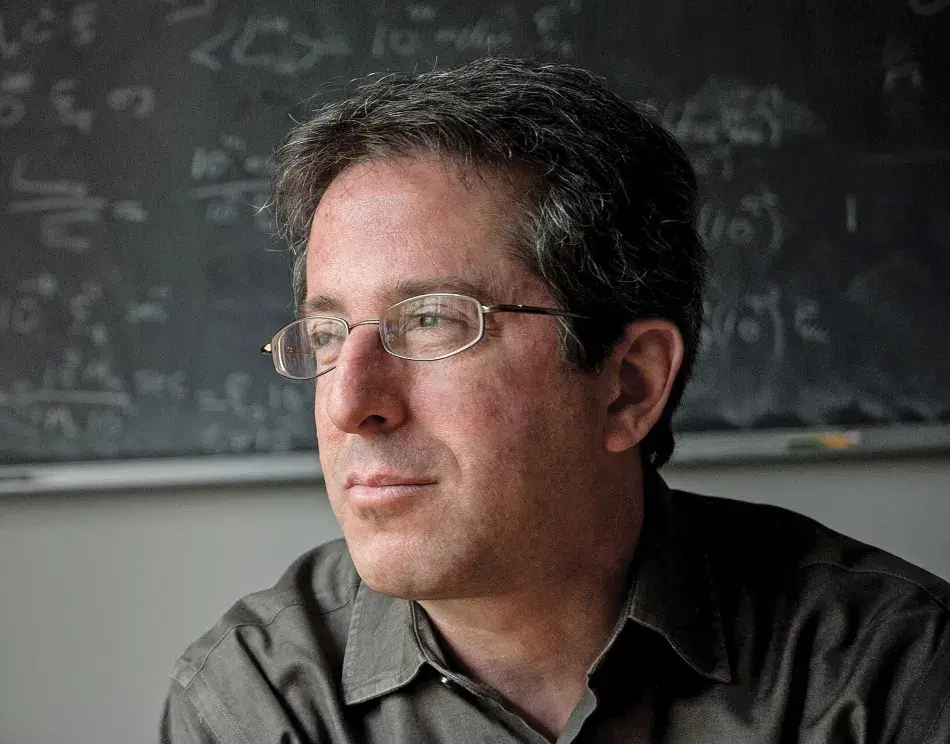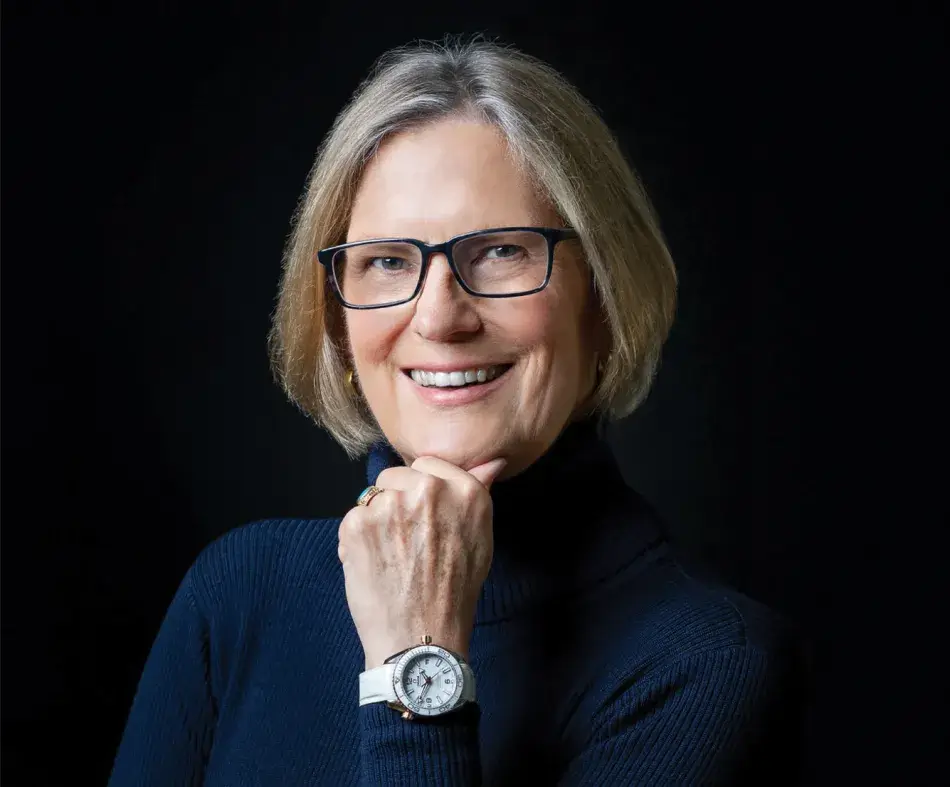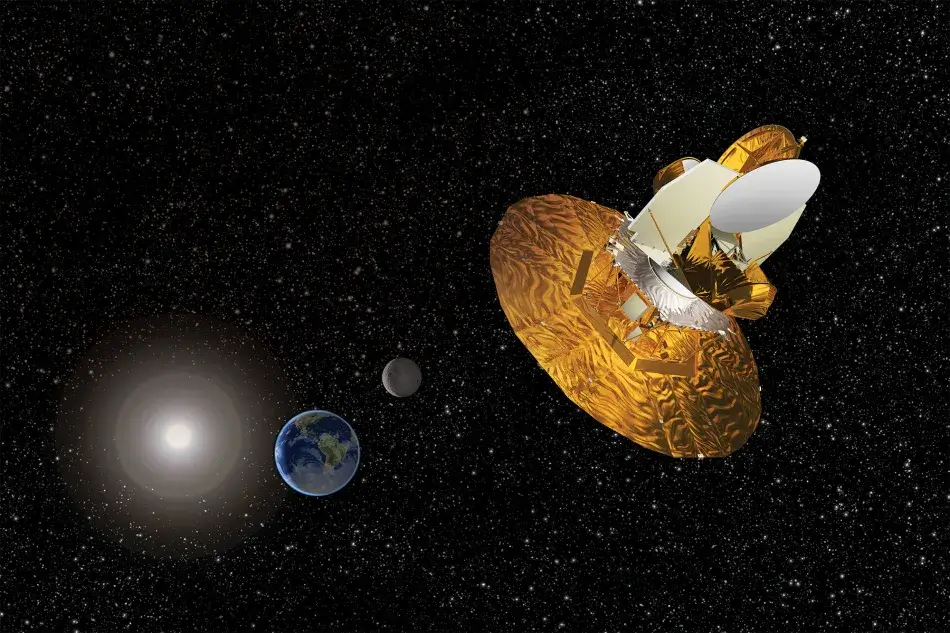
The Rumford Prize, which recognizes contributions to the fields of heat and light, broadly interpreted, was first awarded in 1839 and is one of the oldest scientific prizes in the United States. Previous prize recipients include Thomas Edison in 1895, Edwin Land in 1945, and Enrico Fermi in 1953.
The American Academy awarded the 2021 Rumford Prize to astrophysicist Charles L. Bennett for his contributions to the field of cosmology. The virtual award ceremony included remarks by Academy President David Oxtoby, an introduction from theoretical physicist Marc Kamionkowski, a reading of the Rumford Prize citation by astronaut and scientist Kathryn Sullivan, and a presentation from Charles Bennett. An edited version of the speakers’ remarks follows.
2103rd Stated Meeting | February 10, 2022 | Virtual Event
David W. Oxtoby is President of the American Academy of Arts and Sciences. He was elected a Fellow of the American Academy in 2012.
Thank you for joining us to honor Dr. Charles L. Bennett with the Rumford Prize. As president of the Academy, it is my pleasure to call to order the 2103rd Stated Meeting of the American Academy of Arts and Sciences. In addition to our work as an honorary society and independent research center, the American Academy regularly awards eleven prizes for extraordinary contributions to the sciences, the humanities, public discourse, and the common good.
The Rumford Prize honors remarkable contributions to the fields of heat and light. It was first awarded in 1839, making it one of the oldest scientific prizes in the United States. The list of recipients is an illustration of the ever-expanding possibilities of scientific discovery. Early Rumford Prize awardees include inventors whose work in fields such as refracting telescopes and, in the case of Thomas Edison, electric lighting laid the scientific building blocks for later recipients’ contributions to atomic spectroscopy and laser technology.
Achievements in heat and light allow us today to gather virtually on Zoom from all corners of the globe to honor Charles Bennett for his career-spanning work in experimental cosmology. Chuck’s trailblazing research has elevated and transformed the field of cosmology, offering an unprecedented view of the universe, and reminding us of the joys of scientific discovery. Our program is designed to honor and celebrate Chuck’s invaluable contributions and will include remarks from his colleague Marc Kamionkowski, the conferring of the award by astronaut Kathryn Sullivan, and a presentation from Chuck himself. I am delighted that so many of Chuck’s family, friends, and colleagues as well as fellow Academy members could be here to celebrate his remarkable career.
It is now my pleasure to introduce Marc Kamionkowski, the William R. Kenan, Jr. Professor of Physics and Astronomy at Johns Hopkins University. Marc is a theoretical physicist, who specializes in cosmology and particle physics. His work focuses on particle dark matter, the cosmic microwave background, and cosmic acceleration. Marc was elected to this Academy in 2013. He will begin our program with remarks about his friend and colleague, Chuck Bennett.

I am honored to introduce Charles Bennett, who has been my colleague at Johns Hopkins since I arrived at the university in 2011. Chuck was born in New Jersey, raised in Maryland, and attended the University of Maryland as an undergraduate student. An interesting story that he shared with me is that he was a family friend of Vera Rubin and was doing research with Vera at Carnegie Institution of Washington when he was an undergraduate. When Bernie Burke, a radio astronomer from MIT, was visiting, Vera introduced Chuck to Bernie and said, “This guy’s pretty smart; you should take him.” Chuck wound up going to graduate school at MIT and pursuing a Ph.D. in radio astronomy with Bernie Burke.
Chuck later moved to NASA’s space research laboratory in Greenbelt, Maryland, and joined the team of the Cosmic Background Explorer, COBE, which was awarded the Nobel Prize a few years ago. He also joined the differential microwave radiometer (DMR) project and became deputy principal investigator (PI). Chuck was also the PI for the Wilkinson Microwave Anisotropy Probe, a NASA satellite mission that has revolutionized cosmology and is the reason why we are celebrating him today. WMAP was a remarkable achievement scientifically and managerially. The mission involved identifying, attracting, and managing a very strong team of scientists and ultimately being responsible for the scientific results. He has been awarded numerous prizes for his contributions, all of which are very well deserved. In 2005, Chuck joined the faculty at Johns Hopkins because he wanted to be involved in both education and research.
Let me briefly explain why it is that we are celebrating Chuck today. Chuck is a cosmologist. Cosmology is the study of the origin and evolution of the universe. It is not the study of certain objects in the universe. It is not the study of galaxies or planets. Rather, it is the study of the universe as one physical system. In the 1990s, before COBE, cosmology was a fringe area of physics and astronomy. There was not a lot known about the universe then. We knew that it was expanding, as Edwin Hubble discovered close to a century ago, but the rate of expansion, the velocity with which galaxies were moving away from us, was uncertain to about a factor of two.
At the time there was some evidence for some form of “dark matter,” but estimates of its density varied by about a factor of two. And there were three possibilities for the geometry of the universe: flat, open, or closed. Again, we had no idea of the largest scale structure of the universe, and we had no idea of what it was that formed the seeds that later gave rise to the gravitational amplification of the astounding array of structures that we see in the universe today, things like galaxies and galaxy clusters. It was an order of magnitude game. It was an estimate game. If I told my physicist colleagues that I was a cosmologist they would sneer and say, “Oh, yeah, if you get to a factor of two, you’re doing pretty well. Maybe you should get a real job.”
Chuck changed all of that, and this is the way he did it. If you look at the night sky, you see a bunch of stars (points of light), and if you look with a very bright telescope, you might also see galaxies. But most of the sky is the space in between stars, and that space is dark. However, if your eyes operated not at optical frequencies but at radio frequencies, the sky would look like what we see in Figure 1. This map, made by the Wilkinson Microwave Anisotropy Probe, shows the entire sky as it would look if your eyes operated at radio frequencies and if they could see intensity variations of roughly one part in 105. It turns out that the temperature or intensity of this cosmic microwave background everywhere in the sky is the same to roughly one part in 100,000, but if you look very carefully, which is what the Wilkinson Microwave Anisotropy Probe did, you will see that there are tiny temperature fluctuations – some regions where it is a little bit hotter and some where it is colder. We know that this is the cosmic microwave background, the afterglow of the hot Big Bang. This is literally the cooling embers of the Big Bang that we are seeing.
Figure 1
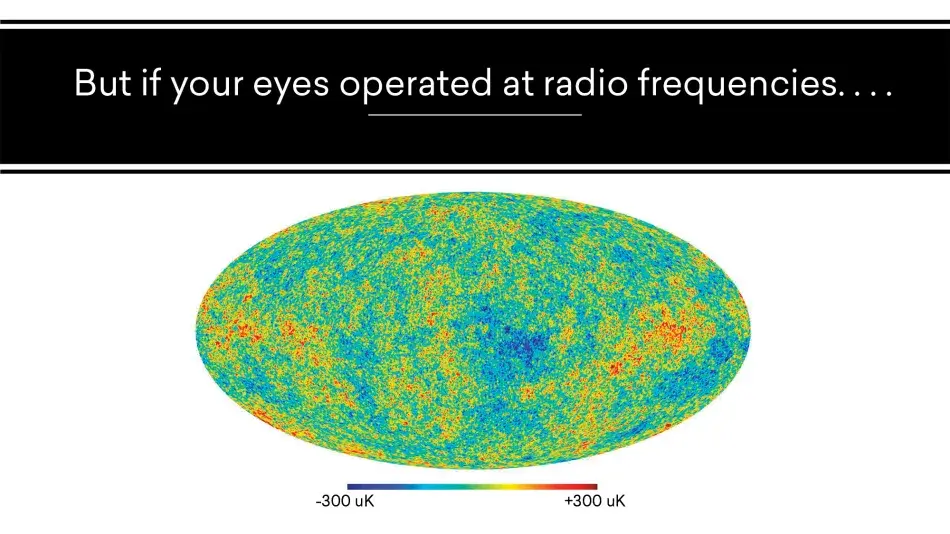
When we look at this cosmic microwave background, we are seeing all the way back to the time when the hot Big Bang took place. We are looking directly at the infant universe. This picture transformed everything. It may not look like a whole lot if you are not a cosmologist, if you are not a physicist, but, as Chuck will explain, we know how to interpret this map and it turns out that there is a huge amount of information in it.
A quarter of a century ago, cosmology was an order of magnitude game; now it is a paragon of precision science. From this data we now know the expansion rate, and the densities of dark and ordinary matter have been determined to a few percent. We know that the geometry of the universe is flat. We have detailed information about the primordial seeds that later gave rise to the growth of large-scale structures like galaxies and galaxy clusters. And moreover, what is perhaps most intriguing is that the characteristics of these seeds for primordial structures are in very good agreement with the predictions of an idea called inflation: an idea for what put the Big Bang in motion. And the idea of inflation, as it turns out, is an outgrowth of ideas in high energy physics. So, in some sense, cosmology has been merged with the study of elementary particles and fundamental physics.
I would like to close by pointing out that Richard Feynman, who all of us in physics revere as much as anybody else, apparently said that you know that a discovery is truly significant if it impacts areas of science well beyond the subfield in which it originated. The cosmic microwave background measurements that Chuck made characterize that as much as anything else that we have ever seen since the development of quantum mechanics. From the cosmic microwave background, we have information about the early universe. Our description of the late universe is founded on discoveries and measurements from the cosmic microwave background. Particle theorists now take this as one of the inputs to all of their theories. It is essential for understanding general relativity, gravity, and quantum gravity. String theorists see it as an avenue toward understanding string theory. It is an essential component of everything we do in extragalactic astronomy and cosmology, and we are even talking about it in nuclear and neutrino physics. Awarding the Rumford Prize to Chuck is extraordinarily well deserved. I would like to congratulate Chuck and say it has been a pleasure to be your colleague and to work in a field in which your research has played such a central role.
OXTOBY: Thank you, Marc. It is now my pleasure to turn things over to another Academy member, Dr. Kathryn Sullivan. Kathy is an oceanographer and astronaut and the first American woman to walk in space. In addition to her work with NASA, Kathy has served as the chief scientist and top administrator of the National Oceanographic and Atmospheric Administration as well as the Aerospace Chair of the Smithsonian’s National Air and Space Museum. Kathy will read the formal citation and present the Rumford Prize to Chuck.
It is my honor to read the citation and present the Rumford Prize to Charles Bennett. The citation reads as follows:
Established in 1839, the American Academy’s Rumford Prize recognizes contributions in the fields of heat and light. The Prize is named for physicist and inventor Benjamin Thompson, Count Rumford, whose challenges to established physical theory were part of the nineteenth-century revolution in thermodynamics. The Rumford Prize recognizes scientific discoveries that have the capability to fundamentally alter our understanding of heat and light and their potential applications. In the words of Count Rumford, the award is for work that “in the opinion of the Academy, tends most to promote the good of mankind.”
For remarkable achievements in “heat and light,” the American Academy of Arts and Sciences hereby recognizes Charles L. Bennett for his cosmos-defining work with the Wilkinson Microwave Anisotropy Probe (WMAP). Early in his career, as a member of NASA’s Cosmic Background Explorer team that measured the faint electromagnetic traces of an infant universe, Dr. Bennett helped to redefine cosmology as a precision science. As chief designer and principal investigator of WMAP, he peered into the furthest corners of space, studied the oldest heat and light, and recorded the first data that describe the age, curvature, composition, and history of the cosmos – validating the theoretical work of Einstein and the early observations of Penzias, Wilson, and their successors. From a sky map of careful measurements, he extrapolated a Standard Model of Cosmology, describing the proportions of matter and energy in the breadth of space as well as the time that has elapsed since the initial expansion of the Big Bang, 13.8 billion years ago. As a result of his research, cosmology is now a central component in the pursuit of the fundamental laws of physics.
Son of a physicist and a photographer, boyhood radio enthusiast and budding astronomer, you have listened to the primordial messages of the universe, calculated their meanings, and provided us with a picture of our origins, as complex and profound as it is beautiful.
Chuck, my heartiest congratulations to you as a cosmologist and a fellow Jerseyite.
Charles L. Bennett, elected a Fellow of the American Academy in 2004, is Bloomberg Distinguished Professor, Alumni Centennial Professor, and a Gilman Scholar in the Department of Physics and Astronomy with a joint appointment at the Applied Physics Laboratory at Johns Hopkins University. He has contributed to the establishment of a standard model of cosmology and is currently engaged in testing and extending that model. He led NASA’s Wilkinson Microwave Anisotropy Probe (WMAP) mission.

I would like to thank David Oxtoby, Marc Kamionkowski, Kathy Sullivan, and especially the American Academy of Arts and Sciences for bestowing this prize on me. I am very humbled and honored to receive it. More personally I want to thank my wife and two sons and my many teachers and mentors over the years. I have learned a great deal from them, and I’m delighted that some of them have joined us for this program. I also want to thank my highly esteemed colleagues. I have had the great fortune of working with very fine scientists over the years and learning from them as well.
I especially want to thank the WMAP science team.1 These days a science team could have one thousand or more people on it. Our WMAP team was much smaller, and everybody made very significant contributions to the success of the mission. It really was a great team effort. Beyond the science team itself there are many people required to build the space mission, including project managers, system engineers, discipline engineers, technicians, people that operate the satellite, schedulers, and more. The mission’s success depended on all of them. I am grateful to them all for their dedication and hard work on WMAP.
As Marc Kamionkowski mentioned, cosmology asks big questions: How did the universe begin? How did the universe evolve? What is the universe made of? What shape is the universe? What will happen to the universe in the future? It would seem to be impossible for us to answer these questions because Earth is a speck of dust in the vastness of the universe. But we can answer those questions because we have a time machine. We can directly observe the past, and it is an action-packed, mind-blowing, time-travel adventure.
The reason why we have a time machine is because it takes light time to travel. It may seem as if light travels instantly, but it doesn’t. Light travels very quickly, one foot per nanosecond. That translates to 186,000 miles per second. That is faster than I have ever driven my car and so, again, it is very fast but it is not infinitely fast. As we look out in the distance, we are necessarily looking back in time, and we don’t have a choice about that. That is the way nature works. We directly observe the past.
Let me give you some examples (see Figure 2). It takes light 0.04 seconds to go across the diameter of the Earth. It takes light eight minutes to go from the Sun to the Earth. In other words, when we look at the Sun, we are not seeing the Sun as it is that instant. We are seeing the Sun as it was eight minutes earlier. It takes five and a half hours for light to go from the Sun to Pluto. The next nearest star beyond our Sun is Proxima Centauri, and it takes four years for light to get to us from there. We live in a Milky Way galaxy. It is a swirling collection of stars, gas, and dust and it takes light 100,000 years to go across the Milky Way galaxy. So, you might think well, that’s an enormous distance and it is, but it’s tiny compared to the universe. As we look out further to the “Hubble Deep Field,” it takes light millions of years to get between these galaxies.
Figure 2
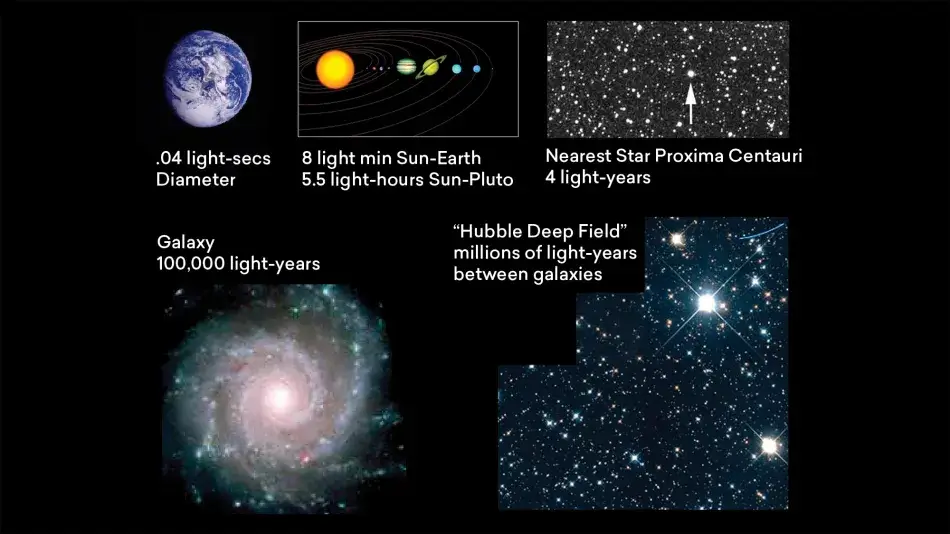
To answer our big cosmological questions we use tools, like the cosmic microwave background (CMB). It is the afterglow from the hot and dense early universe, and it is our time machine to look back almost 13.8 billion years. What we see in this afterglow radiation today is what was in the universe at the beginning of its history. Another tool that helps answer our cosmological questions is that, as far as we can tell, the laws of physics that we measure here on Earth in our laboratories apply everywhere in the universe. We have never seen an example for which that is not true. Sometimes there are conditions in the universe that we can’t recreate in the laboratory, but that is a different thing. Then the universe becomes our laboratory. And our last tool is something we call the “cosmological principle,” which says that every part of space is like every other part. There is no special place in the universe so long as you consider sufficiently large scales. Obviously, our Earth is different from the spot next to us without an Earth there, but you have to go to much larger scales than that to see that every region of the universe is like every other region of the universe.
If you search online and ask what happened at the beginning of the universe, you will see pictures of the Big Bang like in Figure 3. They have a lot in common with each other. They seem to be showing an explosion with rocks and other things coming out. These explosions seem uneven, and this leads to a lot of misunderstandings. People often ask, “What constellation did the Big Bang happened in?” because these pictures show something like that. But this is not what we mean by the Big Bang. In fact, I would say that all these pictures are complete nonsense.
Figure 3

Let me say a word about the Big Bang. The Big Bang theory is the idea that the universe was hot and dense in the past and over the course of billions of years, the universe has been expanding and cooling. What supports this theory is the fact that the universe is expanding. That is what gave rise to the idea that there was an explosion. Some people said that if you play the expansion backwards eventually everything is on top of each other, so there must have been a big explosion. It is true that the universe is expanding. It is not true that you can extrapolate back like that. A few other observations are important to consider here. As you go back to the earlier universe, it was very hot and dense and, at some point, it became a nuclear fusion reactor and it made chemical elements. We see those elements today. The cosmic microwave background itself and its properties as measured by the Cosmic Background Explorer (COBE) satellite are consistent and support the idea that the universe has been expanding and cooling.
If these are not good pictures of what the Big Bang looks like, then what does the hot, dense, early universe look like? A picture of the early universe would be glowing (i.e., hot) and have a highly uniform density, so the picture would be extremely uniform from spot to spot. The idea of the expanding universe is that if you have galaxies in the universe and you wait, you see other galaxies moving apart from each other. We see galaxies moving away from us, but it is not because we are in a special place. All observers in all galaxies see other galaxies moving away. Space itself is stretching, leaving larger and larger distances between these objects. This is what Edwin Hubble found in 1929.
So how then did the universe begin if it wasn’t a Big Bang? The frank answer is we don’t know, but we have an idea that is called “inflation.” I note Marc Kamionkowski used the same word, idea, in his introduction. Basically, the idea is if you go back far enough in time to hot temperatures and small distances you must take quantum mechanics into account. And in the quantum world there are fluctuations all the time. The inflation idea is that a quantum fluctuation much smaller than the size of a proton, that is, a subatomic fluctuation, inflates to a macroscopic size in a tiny fraction of a second. I mean in a trillionth of a trillionth of a trillionth of a trillionth of a second. Not only is this remarkable, but it allows us to use quantum physics to generate a universe out of nothing. It is the ultimate free lunch! By the way, while this expansion is occurring, you pick up additional quantum fluctuations; fluctuations are generated on all different scale sizes and these quantum fluctuations get converted into what we call classical fluctuations. Inflation is our best idea for the beginning of the universe. We don’t know for a fact that it is a correct theory or idea, and we certainly don’t know which specific theory under the inflation umbrella would be the right one. Although we have ruled out many, there are many left. So where do we go from there?
In cosmology we can’t experiment; we can only observe. In almost every other area of science you do experiments, which involve perturbing some system, poking at something, and seeing how it responds, whether it is an animal or a chemical. With the universe, we can’t experiment. There are many people who have expressed their gratitude that I can’t experiment with the universe! So we observe. We map the cosmic microwave background over the full sky and analyze the statistics of the fluctuations we observe in that map. Then we ask the question, what cosmological ingredients led to the fluctuation statistics of that map?
This is not easy to do because the fluctuations are extremely faint, and we need to avoid disturbances and interference from Earth’s environment. That led us to the decision that we needed a space mission away from Earth. On June 30, 2001, at 3:46 pm WMAP launched on a Delta II rocket from the Kennedy Space Center in Florida (see Figure 4). The rocket took the mission on what we call phasing orbits around the Moon so we could steal a little of the Moon’s gravity and use it as fuel to get the spacecraft out to an orbit around the second Lagrange point of L2. If you have been following the James Webb Space Telescope, the telescope is now in an orbit around L2. The reason L2 is a valuable observing position that WMAP pioneered, and now other observatories have gone there too, is because you can see that the Sun, the Earth, and the Moon are all behind the satellite (see Figure 5). The satellite has a big shield protecting the instruments from the microwave radiation from those objects, which is a billion times stronger than what we are trying to measure. There are also solar panels for power and a communications antenna, pointed back toward the Sun, the Earth, and the Moon. The telescope reflectors look out into deep cold space. The satellite spins and orbits around the Sun and that allows us to sweep out all the spots in the sky, to measure all the spots, and make the map of the full sky.
Figure 4
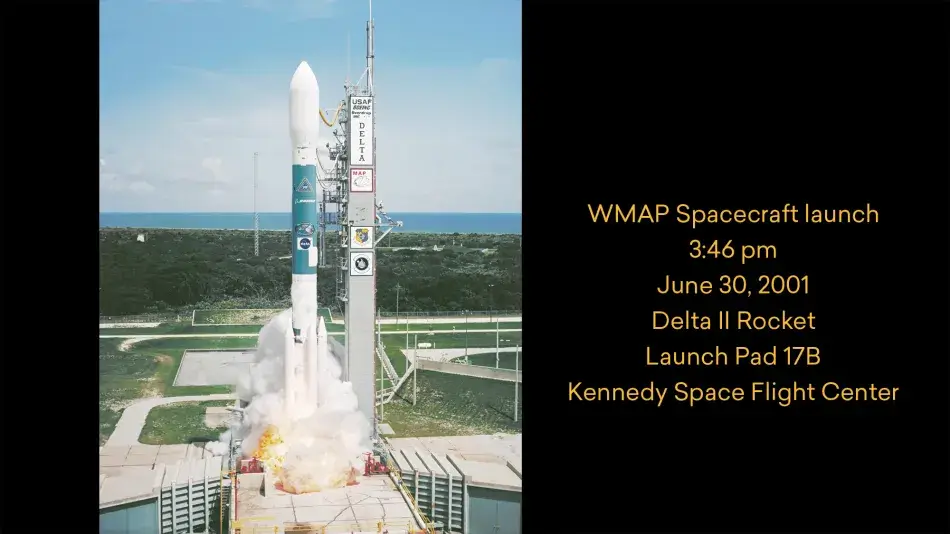
Figure 5

The spacecraft carried five instruments aboard that measured at five different frequencies (see Figure 6). What we see is a projection of the full sky. Every spot on the sky is somewhere on here. The most obvious thing you see is the red stripe across the center and that is because we live in the Milky Way galaxy and the red stripe represents microwaves from our own Milky Way galaxy. They’re fascinating, but they are in the way of what we are trying to measure. So we have to either model that emission and subtract it, or where it is too strong just cut out those parts of the map and not use them.
Figure 6
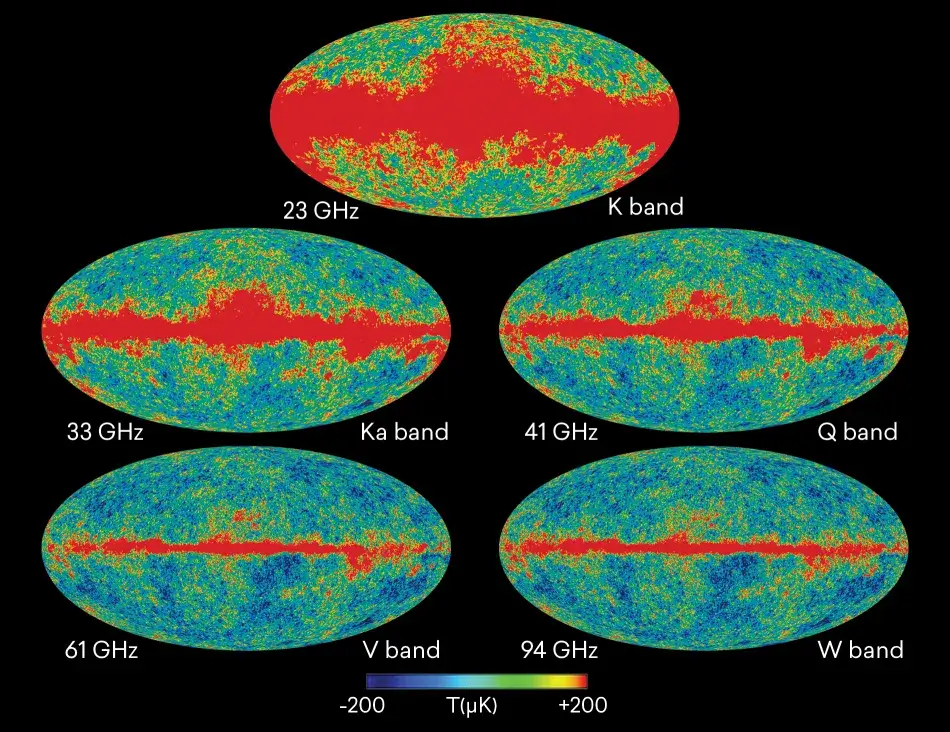
When we remove this microwave emission, the map we end up with is shown in Figure 7. This is a map of light that has been traveling across the universe for 13.8 billion years. We are seeing directly what the universe was like 13.8 billion years ago. What we need to do next is analyze the statistics of these fluctuations in the map and ask, how did this map come to be?
Figure 7
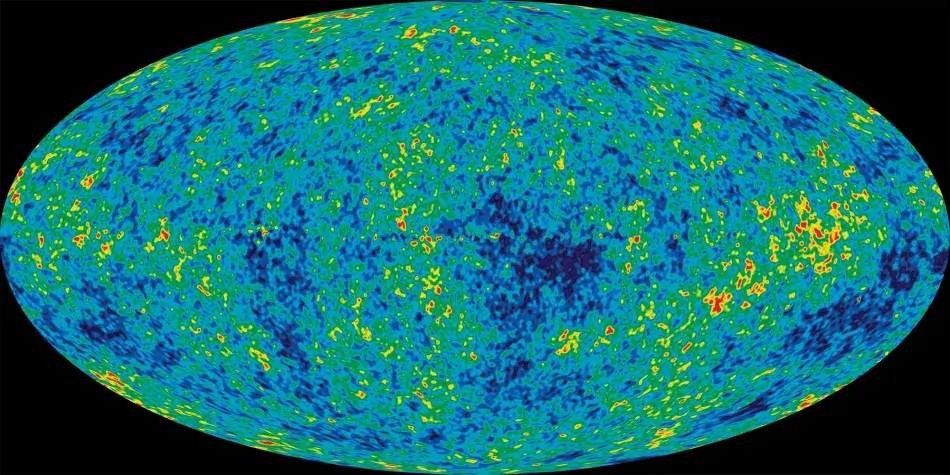
Upon analysis, we find the age of the universe is 13.77 ± 0.06 billion years. The contents of the universe consist of atoms, cold dark matter, and dark energy. Cold dark matter makes up 25 percent of the universe and it is either a particle or particles that we have not identified that don’t interact with light. That means they don’t give off light and that is why we call it dark: it doesn’t block light; it doesn’t scatter light. It sounds strange to have a particle that doesn’t give off any light or absorb light, but we actually have candidates for what this might be: axions, axion-like particles, or neutralinos. People have been searching for some time trying to identify which particle or particles make up this cold dark matter. I’m hopeful that we will determine what this is. From a cosmological point of view, the most important thing is that we understand how it acts, which is that it gravitates but doesn’t interact with light.
Dark energy makes up 70 percent of the universe. Dark energy may be the biggest problem in all of physics. Whatever it is, we don’t understand it, but the fate of the universe depends on knowing what it is. Albert Einstein introduced his theory of general relativity, and very quickly applied it to the universe. I think he was both surprised and disappointed that it didn’t make a universe that was stable. As far as he knew at the time, the universe was stable. So he introduced a fudge factor into his equations called the “cosmological constant.” It acts like an anti-gravity. He set its value exactly equal to the gravity value of matter in the universe and with this balance attempted to make the universe stable. Once Hubble discovered the universe isn’t stable, that it’s expanding, Einstein realized his mistake. However, maybe realizing it was a mistake was a mistake because it appears that the universe does indeed have something like this. The cosmological constant is an example of a dark energy candidate, and we do observe an accelerated expansion of the universe today that is being driven by this dark energy, but we don’t understand at all why the dark energy has the value that it has. It’s a very odd value. It is not at all what we would predict. In fact, the value we predict would be much larger, and physicists have known for a long time that the high value is just not possible. So, the assumption has been that there must be some way to cancel it – to make it zero. But it appears only to cancel 121 of the 122 orders of magnitude needed to get to zero, so we end up with an unexpected small, non-zero cosmological constant.
Another possibility is that it is an environmental variable. If inflation created our universe maybe it created other universes and maybe this value just gets thrown in randomly in different universes in different ways. Most of these other universe possibilities wouldn’t have the right properties to generate planets and life, thus there are no observers who could ever see them, so we have an observer’s bias. This is basically an anthropic argument, and I and many physicists I know hate this argument. However, we grudgingly admit that it might be true. But believing it is true is equivalent to giving up, so we are going to try hard to see if there’s some other explanation.
Without going into the details, the cosmological constant by its name is constant whereas the other possibility is that there could be a field that fills the universe that is changing with time. There are a lot of measurements trying to pin that down. Finally, Einstein could have been correct to begin with. There could be a flaw in his theory of gravity that is showing up, appearing as dark energy, and maybe we need a modified gravity model. As Yogi Berra says, “It’s tough to make predictions, especially about the future.” We can’t predict the fate of the universe without knowing what this dark energy is.
I have left the atoms to last, which make up 5 percent of the universe. Atoms are something we know about because we are made of atoms; our houses are made of atoms; everything we come into contact with is made of atoms. In the cosmology business we call atoms “baryons.” I mentioned previously that early in the history of the universe, when it was hot and dense, there were nuclear fusion reactions that made atoms in the first three minutes of the universe. Atoms are made now in nuclear fusion in stars. If we use the results of the COBE satellite mission, we get the density of photons in the universe: 411 per cubic centimeter. A region the size of a cube of sugar would hold 1,500 photons. If we use the WMAP data, we know the baryon density of the universe, and if we take the ratio, we learn that there are a billion photons for every baryon. This turns out to be the only free parameter in the early universe’s creation of light chemical elements.
Before WMAP, when we didn’t know this number very well, we would observe primordial clouds, measure the light chemical element abundances, and deduce what this ratio number was. But since WMAP, we have a very good value for this number. We can use the cosmic microwave background to predict what the abundance ratios are of 4He (Helium), D (Deuterium), and 7Li (Lithium). It turns out if we compare these two techniques, 4He and D agree very well between the primordial clouds and what we measure in the early universe, but for some reason 7Li is a little bit off. It has always been a curiosity of mine why that is. Everything I have ever read in any paper says this will be explained soon. The trouble is I have been reading such things for years, and people keep closing off avenues of explanation, so it’s still a curiosity to me.
Let’s turn now to the shape of space. There are three possible shapes of space (see Figure 8). The bottom one is the shape that you are most familiar with. If you draw a triangle on a piece of paper and measure the interior angles, they add up to 180 degrees. If you have a triangle that you draw on a horse saddle, the angles add up to less than 180 degrees. And if you draw a triangle on a ball, they will add up to more than 180 degrees. So if you draw a triangle in space, the angles have to be either more than, less than, or equal to 180 degrees. There is no other possibility. With the cosmic microwave background we essentially have a big triangle in space, and we have tried to assess the curvature of space. We observe the cosmic microwave background, but this light traveling across the universe is subject to the curvature of space. That allows us to determine the universe’s geometry. And it turns out to be the one we are most familiar with: flat Euclidian geometry. The measurement is within 0.5 percent. This is a high-quality determination that we live in a universe with Euclidian or so-called “flat” geometry. Why is this important? Because the inflation picture that I pointed out earlier actually predicts this. It predicts it because of the enormous expansion of the universe, whatever curvature existed before, it would grow to such an extent that it would appear flat or Euclidian to us. So we can put a check mark next to that prediction. Again, inflation has many theories, but I’m referring here to generic predictions of inflation across the versions.
Figure 8
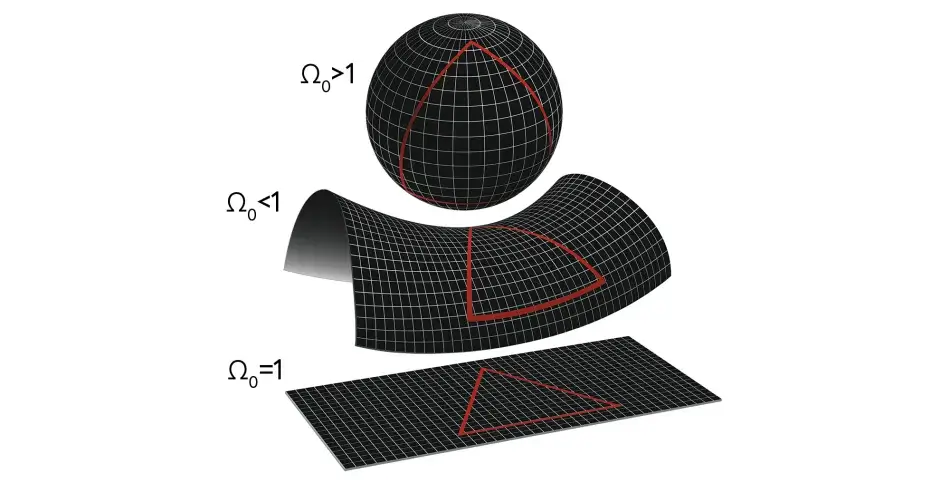
Another thing that we know about inflation is that if it happened, it slowed down and eventually stopped. The universe is not still inflating from the early times. While normally inflation would give you equal fluctuation power on every size scale, it had to slow and stop and that predicts a slight unevenness, a little more fluctuation on large scales than small scales. WMAP detected this for the first time. This is another check mark for inflation. There are other generic predictions of inflation, such as an equal number of hot and cold spots in the map. And so, inflation so far is making successful predictions. Again, it doesn’t mean it is true. It just means that it is looking good. A statement of mine made the “quotation of the day” in The New York Times on March 17, 2006: “It appears that the infant universe had the kind of growth spurt that would alarm any mom or dad.” It helps to have kids when you’re working on these things!
Graphic artist Britt Griswold and I, with the help of Gary Hinshaw, made the graphic in Figure 9 that has become ubiquitously popular. The idea is the universe starts with quantum fluctuations that inflate to a macroscopic size. Then we have an afterglow light pattern that was put in place when the universe was 375,000 years old. I call the period after that the Dark Ages because no stars have yet formed to give off light. There is no starlight. There is still the cosmic microwave background (although it was then a much higher energy radiation), but the first stars don’t form until some 400 million years later. And then what the diagram shows is the Big Bang expansion of the universe over 13.77 billion years, when the universe is expanding and gravity is doing its thing: generating galaxies and planets and the structures that we see in the sky with telescopes. Toward the end, we see this surprising accelerated expansion. Instead of the expansion slowing down, which you might expect, it is speeding up because of the dark energy component. A question then becomes, is that going to continue or is it going to reverse and collapse? We don’t know the answer right now. But as Yogi Berra said, “We can observe a lot just by watching.”
Figure 9
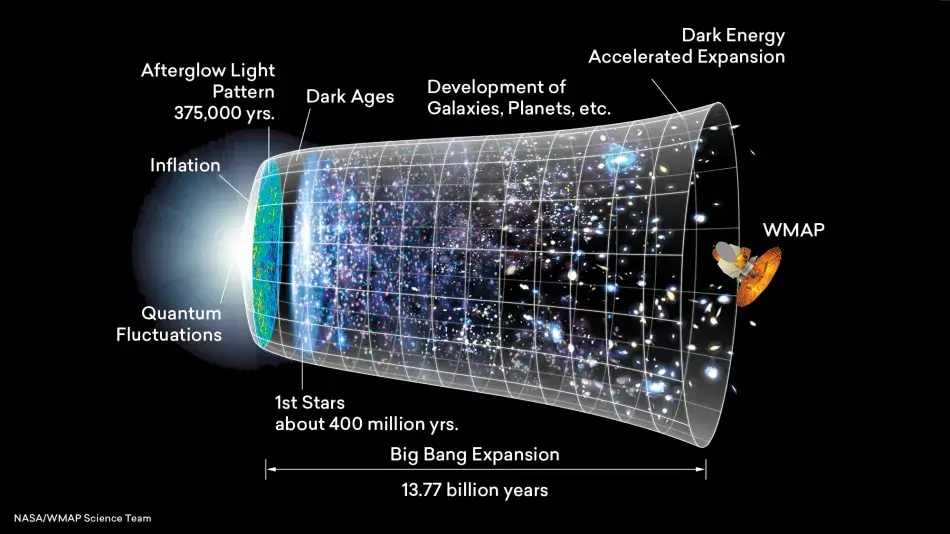
With WMAP we can predict what is going on in the universe at any time. We can predict what the expansion rate of the universe should be today, and that is the early universe number that we see in Figure 10, 68.34 km/sec/Mpc. But we can also measure what the expansion of the universe is today, the Hubble constant, and that is the late universe measurement, 72.61. Though these are close to each other, they are not really close enough. If we look at the number line, each of those brackets represents a 95 percent chance that the measurement is consistent within that range, but they don’t overlap and that is not a good thing. Some of my colleagues think there is a mistake somewhere here, but I have to say that if there is a mistake, it is far from obvious. Data sets have been interchanged; analysis has been done by independent people. It’s not unlikely that what we are seeing is some deviation from the model that may be a new piece of cosmology or a new piece of knowledge. We certainly shouldn’t discount that possibility. I find this to be extremely important and exciting.
Figure 10

So we have several unanswered questions.
- What is the Dark Energy?
- What is the Cold Dark Matter?
- Did inflation happen, and if so which kind? This is a tall order because we need a quantum theory of gravity, and we don’t have one.
- Why is there an expansion rate (Hubble constant) inconsistency?
- Why is the photon-to-baryon ratio so big?
- Why is there a gap in the early universe synthesis of 7Li?
I would like to close with a thought of Einstein’s that resonates with me: “The most incomprehensible thing about the universe is that it is comprehensible.” We have more to learn, and we are going to keep working at it.
OXTOBY: Thank you, Chuck. We have time to take some questions and comments from the audience. I will start with the first question. In 1996, the Rumford Prize was awarded to John Mather for his contributions to understanding the cosmic microwave background. Are there connections between his work and yours?
BENNETT: That’s a very good question. The Cosmic Background Explorer, COBE, was an extremely important space mission. It did breakthrough science. One experiment on COBE measured the spectrum of the cosmic microwave background, and determined it was a blackbody. That really cemented the Big Bang theory, ending the competing theories. It also gave us the photon density of the universe. People treat it now as a constant of nature, but it’s a measured quantity from COBE. The other thing COBE discovered was the temperature fluctuations I showed in the WMAP map. People searched twenty-seven years for those fluctuations until COBE finally detected them. And that was a motivating factor for our WMAP proposal. Now that we knew that they were there, and we knew how bright they were, we could design a mission to go study the fluctuations. So COBE was very much the mother of WMAP.
AUDIENCE MEMBER: Since we are celebrating Chuck Bennett, I want to make sure people know that Chuck participated in COBE, which was awarded the Nobel Prize for two things. One was the measurement of the blackbody spectrum, which was 2.7 Kelvin. The other was that it was the first to see the structure at a very tiny scale. A lot of people had seen other things before that. They had seen that the sky was hot in one corner and cold in another, but COBE saw it even better because of the motion of the Earth around the Sun. This was quite exceptional but had never been measured. If Chuck hadn’t been part of that experiment, it would never have been measured. Chuck realized very early that the sensitivity of the device that was going to measure that anisotropy was not good enough to make the measurement. And that was a profound observation. Chuck made it so that the instrument was improved. So I hold Chuck responsible for the very first measurements of that structure, which later was measured by WMAP so exquisitely. He helped to earn that Nobel Prize.
AUDIENCE MEMBER: As a topologist I wonder about the implications for the qualitative geometry of space as a whole. Does the model that you have been describing, which involves inflationary expansion, tell us something about the cosmos as either a three-dimensional or four-dimensional manifold? Does it dictate that the geometry of the overall shape, not the curvature, is Euclidian?
BENNETT: Earth has a curved surface, but to us it looks flat because the radius of the curvature is so large. The whole idea of inflation is that you are driving the radius of the curvature to such an enormous value that locally it looks flat. What do I mean by locally? We have a concept of the observable universe. That is the part within a horizon where light has had time to come to us. When we observe the universe, we don’t observe the whole universe. We only observe out to a certain distance, and beyond that light hasn’t had time to get to us. We measure and quantify the Euclidian geometry within 0.5 percent. That’s within our horizon. We don’t know what goes on beyond our horizon because we can’t observe it.
OXTOBY: Last week, the Academy’s project on Challenges for International Scientific Partnerships published the final of three reports that offer recommendations for strengthening international scientific collaborations. I’m curious about your work and the extent to which it has benefited from international scientific collaboration.
BENNETT: What I did not mention is that WMAP was a very inexpensive satellite as satellites go. Its price was 1 percent or less than the cost of the James Webb Space Telescope. Most space missions have some international collaboration largely because single nations can’t afford to do expensive things by themselves. And you get the benefit of expertise from around the world. Because WMAP was so small and we had such a tight budget, it was essentially a domestically funded mission with a domestic team, though we had some Canadians participating with us on the science team. I have to say that WMAP is more the exception than the rule. These days it would be hard to name a space mission that does not involve some international collaboration.
OXTOBY: A final question: How do you see the field of cosmology changing in the future?
BENNETT: I think things are about to change quite a bit. Very soon the James Webb Space Telescope is going to be collecting data. We also have the Vera C. Rubin Observatory that is going to be surveying the sky and giving us a flood of data. And then we have the Euclid space mission from the European Space Agency, which NASA is collaborating on; I am a part of that space mission too. We have the Nancy Grace Roman Space Telescope that NASA is going to be launching. There is the Subaru Prime Focus Spectrograph. There is the Simons Observatory and CMB-S4. All kinds of things are happening. And they are largely aimed at the things that I discussed: What is dark matter? What is dark energy? And what about inflation? I am amazed by the amount of data that is going to be coming in. It’s a very exciting time for cosmology.
© 2022 by Marc Kamionkowski, Kathryn Sullivan, and Charles L. Bennett
To view or listen to the presentation, visit www.amacad.org/events/charles-bennett-rumford-prize.
